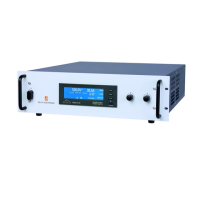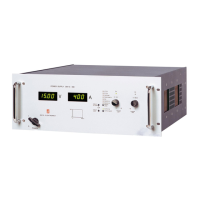GENERAL SM15K
8 / 32 DELTA ELEKTRONIKA B.V. rev. January 2021
The SM70-CP-450, SM210-CP-150, SM500-CP-90 and
SM1500-CP-30 can either be used as a constant voltage sink
and source with current or power limit, or as a constant
current sink and source with voltage or power limit.
The change of mode occurs at the crossing of the voltage,
current and power settings. Fig. 4 - 1 shows the output
ranges.
4.2
BI-DIRECTIONAL OPERATION
The unit operates in source or sink mode and changes over
between modes depending on the settings and the load
conditions at the DC power terminals.
Warning! When using the unit as a load, the user needs to
take care the voltage of the source connected to the DC
power terminals is not exceeding the maximum allowed
voltage, a too high voltage or overshoot can damage the unit.
Note that the inductance (like cable inductance) in series with
a voltage source can cause a voltage overshoot at the DC
power terminals, when switching the output from “ON” to
“OFF” or switching off the mains.
Via the user menu the amounts of sink power and source
power can be set between 15kW and almost zero
independently from each other.
4.3
Both in Source and in Sink mode, the unit can operate in
Constant Power mode.
The user can select any value between the maximum power
and zero watts separately for source and sink mode
depending on the DC load and mains supply.
4.4
Warning! The output can be damaged by voltage overload.
The power supply is fully protected against all overload
conditions, except connecting a voltage source, exceeding
the maximum allowed voltage, to the DC power terminals.
The display indicates OL in case of a voltage overload of
102.5% or more.
The DC power terminals automatically disable at a voltage
overload of 105% or more, the display indicates PROT.
4.5
The power supply works on a three phase AC mains voltage
and has a wide voltage range.
No neutral connection is required.
In case of a low AC voltage or missing phase, the AC-Fail
status will be high.
4.6
The unit has active power factor correction (PFC). The AC
input current will therefore almost be a sine wave. This
means that the RMS-value and the harmonic distortion of the
AC input current will be relatively low.
4.7
AC INPUT POWER WITH DC OUTPUT OFF
The unit consumes little power when the DC output is
switched off. This makes it possible to leave the AC input
powered on when the DC output is disabled by the Output
On/Off function.
The DC output can be switched On/Off via a push button on
the front panel or by remote programming.
4.8
The DC output voltage is available quickly after mains switch
on.
The exact specifications can be found in the datasheet.
fig 4 - 1
DC Output voltages and currents.
Every point in hatched area can be used.

